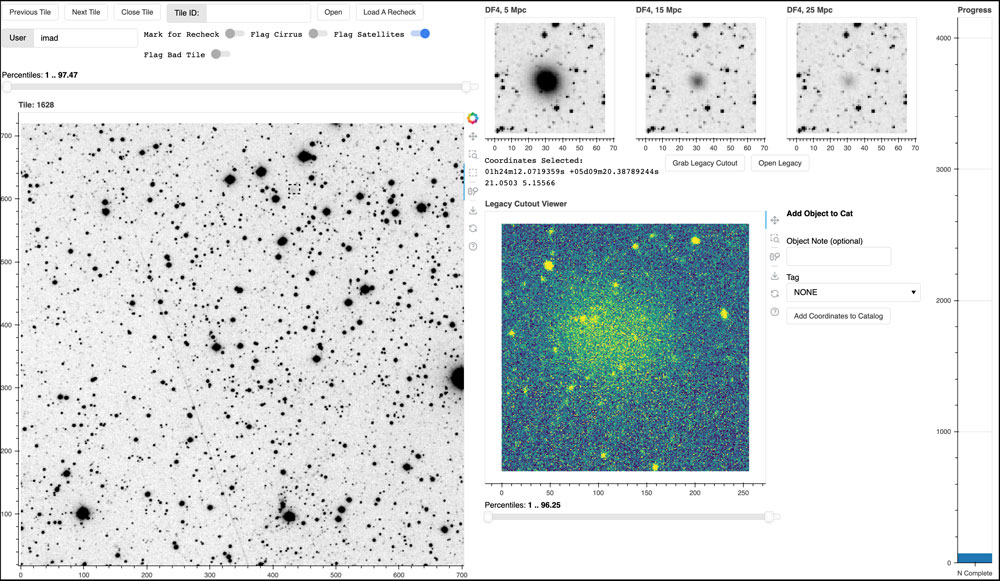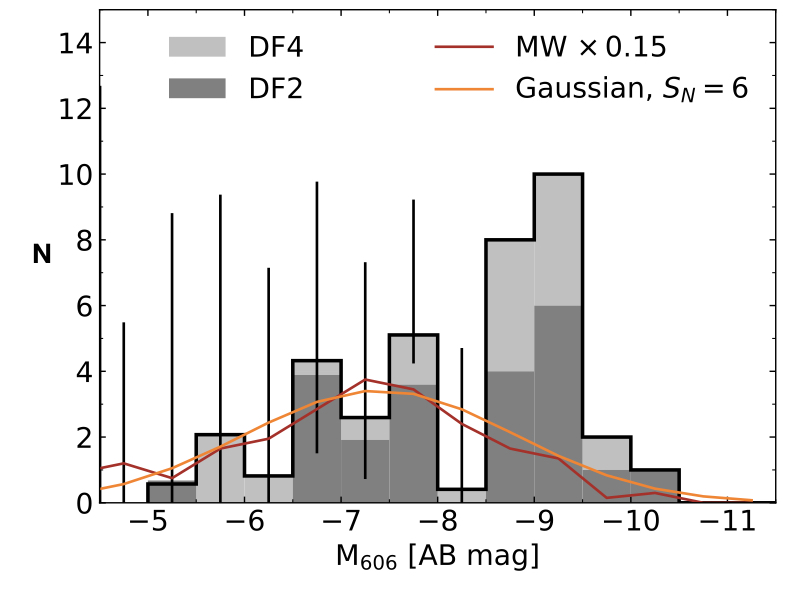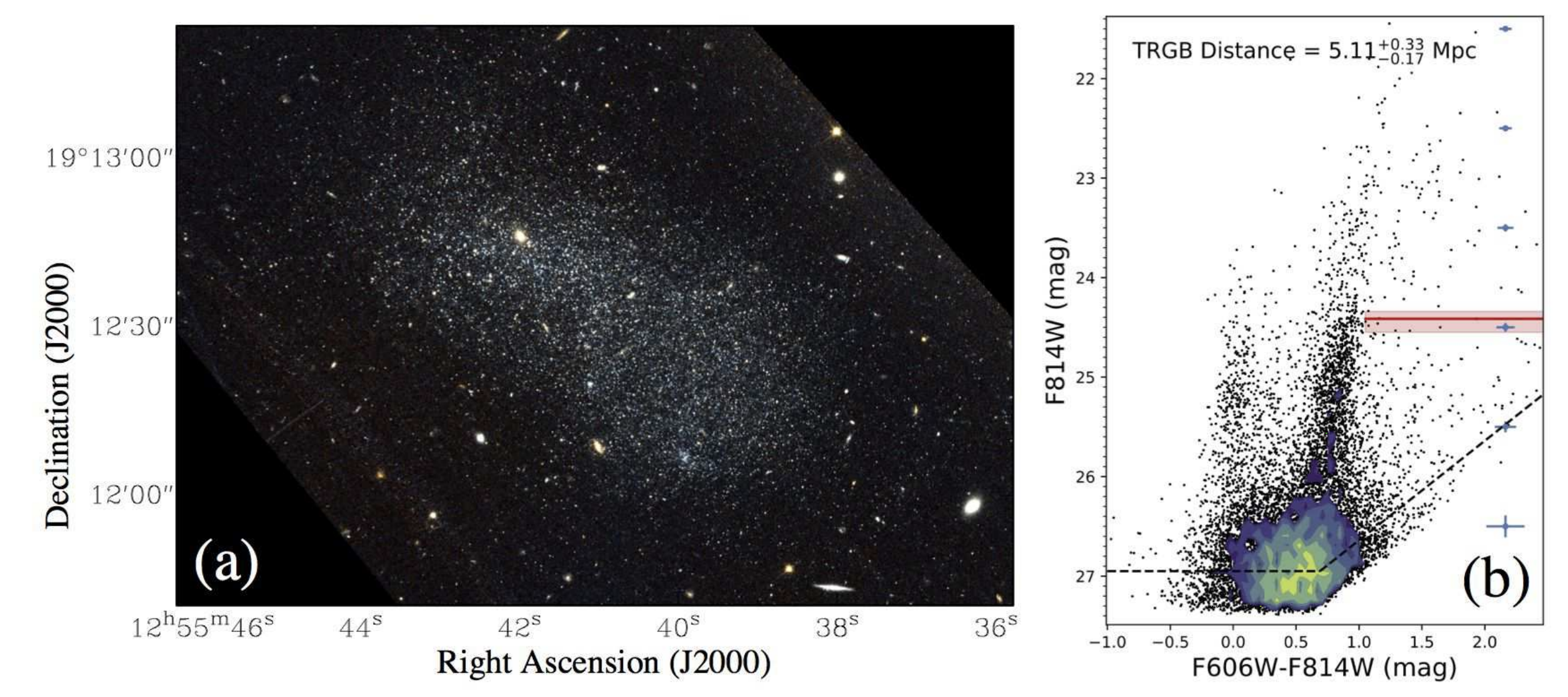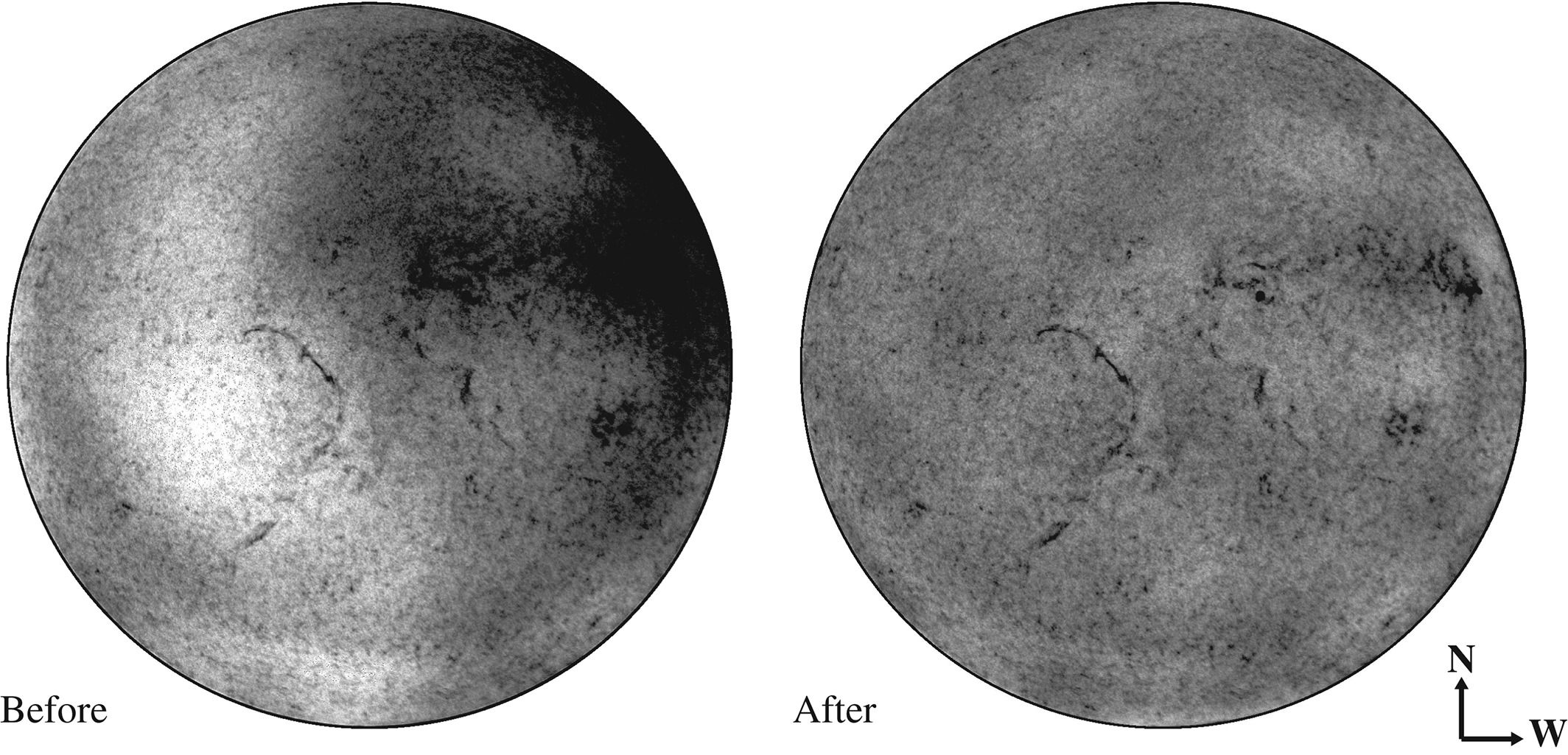Research
Ongoing Project: The Dragonfly Ultrawide Survey
 Existing galaxy surveys could be missing a population of apparently large, diffuse, quiescent galaxies due to their extremely low surface brightness.
This population includes nearby Ultra-diffuse Galaxies (UDGs) which are dwarf galaxies that are at least 1.5 kpc in size.
They are difficult to characterize because most known UDGs are in clusters and are too distant for detailed follow-up.
Theory papers have predicted a dozen of UDGs within 2.5 Mpc (~2 within the SDSS footprint), which would make their apparent sizes several arcminutes.
The Dragonfly Telephoto Array is uniquely optimized for imaging this type of large, low surface brightness objects in integrated light.
With its 6 sq. deg. field of view and a relatively unobstructed light path, Dragonfly has unprecedented sensitivity to low surface brightness
features and exquisite control over background systematics.
Existing galaxy surveys could be missing a population of apparently large, diffuse, quiescent galaxies due to their extremely low surface brightness.
This population includes nearby Ultra-diffuse Galaxies (UDGs) which are dwarf galaxies that are at least 1.5 kpc in size.
They are difficult to characterize because most known UDGs are in clusters and are too distant for detailed follow-up.
Theory papers have predicted a dozen of UDGs within 2.5 Mpc (~2 within the SDSS footprint), which would make their apparent sizes several arcminutes.
The Dragonfly Telephoto Array is uniquely optimized for imaging this type of large, low surface brightness objects in integrated light.
With its 6 sq. deg. field of view and a relatively unobstructed light path, Dragonfly has unprecedented sensitivity to low surface brightness
features and exquisite control over background systematics.
We have recently completed the Dragonfly Ultrawide Survey (DFUWS), which covers the entire SDSS footprint in g- and r-band imaging. The 30-minute integration times yield surface brightness limits below 29 mag/arcsec^2 on 1'x1' scales. From 3000 sq. deg. of DFUWS early internal release data, we identified eleven large, low-surface-brightness galaxies and obtained Keck/KCWI spectroscopy for their radial velocities. This sample of quiescent, large, diffuse galaxies range between 12-25 Mpc in distance, and their apparent sizes are all smaller than 30". As our search for arcminutes size UDGs continues, LSST will provide a complementary dataset in the Southern sky and cover a much wider area. We hope to expand the search for new UDGs with LSST data.
Stay tuned for the updates on this project!
Past Projects:
5. KCWI velocity dispersion measurement of NGC1052-DF4.
Shen, Z., van Dokkum, P., Danieli, S., 2023, ApJL, 957, L6
NGC1052-DF4 has been proposed to have little to no dark matter based on the low velocity dispersion of its globular clusters.
However, this velocity dispersion could also be explained if the galaxy has a cored dark matter profile.
To distinguish between the stars-only model (which predicts a dispersion of 6-10 km/s) and a cored DM profile (larger than 10 km/s),
we need to accurately measure the internal velocity dispersion of the galaxy.
We obtained 12 hours of observations using KCWI. From the high-resolution spectrum, we found that the velocity dispersion is indeed consistent with no dark matter.
 4. TRGB Distance to NGC1052-DF2.
4. TRGB Distance to NGC1052-DF2.
Shen, Z., Danieli, S., van Dokkum, P., et al., 2021, ApJ, 914, L12
As the first "dark matter deficient" galaxy, NGC1052-DF2 sparked many debates. Some argue that the apparent lack of dark matter and the overly luminous
globular clusters can both be explained if the galaxy was much closer to us, compared to the canonical distance of 20 Mpc.
Here we present 40 orbits of HST ACS
data for NGC 1052–DF2 and use these data to measure the Tip of the Red Giant Branch (TRGB). The TRGB is readily apparent in the
color-magnitude diagram. Using a forward model that incorporates photometric uncertainties,
we find a distance of 22.1 Mpc.
In addition to confirming the unusual properties of NGC1052-DF2, we also find a well-determined 2.1 Mpc separation between NGC1052-DF2 and NGC1052-DF4.
The relative distance may be the key to understanding the origin of both galaxies.
 3. Globular cluster luminosity function in NGC1052-DF2 and DF4.
3. Globular cluster luminosity function in NGC1052-DF2 and DF4.
Shen, Z., van Dokkum, P., & Danieli, S., 2021, ApJ, 909, 179
The dark matter deficient galaxies NGC1052-DF2 and NGC1052-DF4 also have unusually luminous globular clusters (GCs). In the luminosity function shown above,
we combine the GC samples in both galaxies and compare it to the near-universal GC luminosity function. The GCs in these galaxies are almost 2 magnitudes
brighter than the expected peak.
 2. Discovery of a recent starburst in the dwarf galaxy KDG 215.
2. Discovery of a recent starburst in the dwarf galaxy KDG 215.
Cannon, J. M., Shen, Z., McQuinn, K. B. W., et al. 2018, ApJ, 864, L14
Dwarf galaxies like KDG 215 probe the low-mass end of galaxy formation.
Although KDG 215 is unusually gas-rich, it is currently inactive in star formation.
To investigate its evolution, we used HST archival images to construct color-magnitude diagrams (CMDs).
I restructured and streamlined the data analysis process. I also managed the extensive GitHub repository for our CMD matching tool.
With the Wrangler supercomputer at the Texas Advanced Computing Center, I reconstructed the star formation history of KDG 215 by
matching the observed CMD to synthetic CMDs from stellar evolution models.
The result of the best fit revealed a surprisingly unusual star formation history for this galaxy.
While most galaxies form stars early on and continue to form stars, KDG 215 only formed around 40% of its total stellar mass until one billion years ago.
Then, it experienced an active episode of star formation followed by a gradual decline to its current inactive state.
We discovered an extreme case of stellar feedback suppressing star formation.
 1. Solar chromosphere data calibration pipeline.
1. Solar chromosphere data calibration pipeline.
Shen, Z., Diercke, A., Denker, C.. 2018, Astron. Nachr., 339, 661
In the summer of 2018, I developed a method to remove instrumental artifacts from solar images and incorporated it into the reduction pipeline.
I joined the optical solar physics group at the Leibniz Institute of Astrophysics Potsdam, under Prof. Carsten Denker.
We studied the migration of solar filaments which revealed the cyclic variation of the magnetic field.
Measuring the kinematics of solar filaments required accurate full-disk Doppler maps.
In our dataset, uneven filter transmission left a systematic yin-yang pattern and significantly impaired velocity calculation.
I developed a method using Zernike polynomials to characterize and remove the image artifacts. After removing the artifacts,
I calibrated the obtained Doppler maps with high-resolution spectrograph data.
The pipeline was implemented in IDL and optimized to re-process archival data taken in the past six years.
The pipeline has been added to the sTools solar data reduction pipeline
for all future data processing.
This new method can be applied generally to calibrate full-disk solar images, and it will facilitate studies of solar filament migration.

 OrcID: 0000-0002-5120-1684
OrcID: 0000-0002-5120-1684



